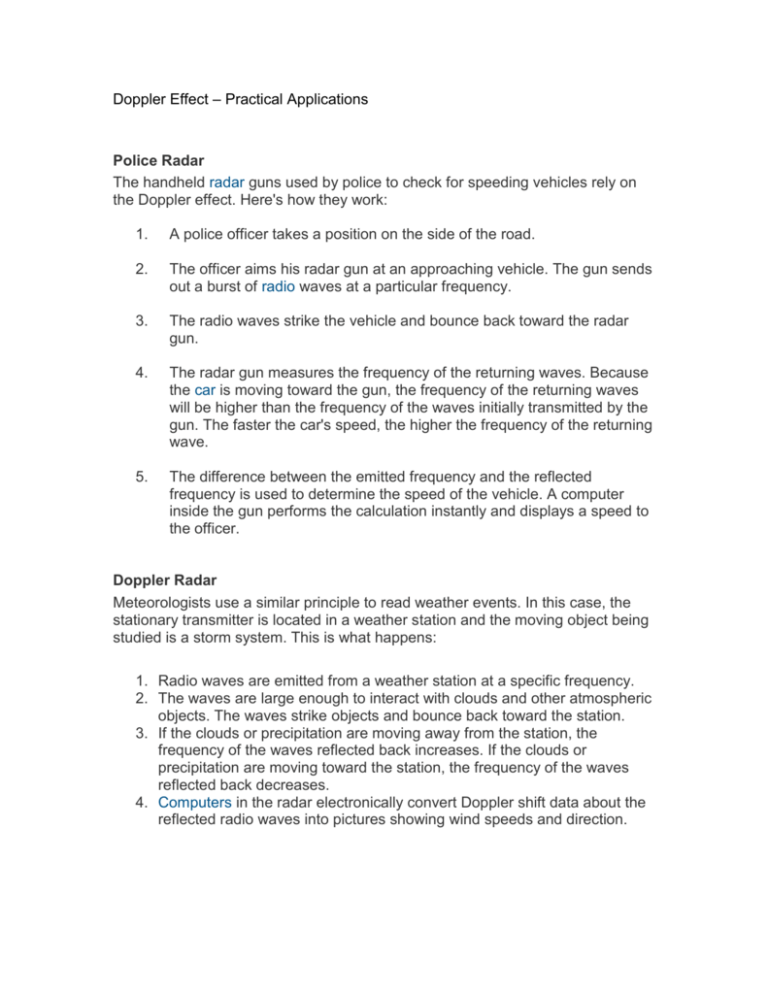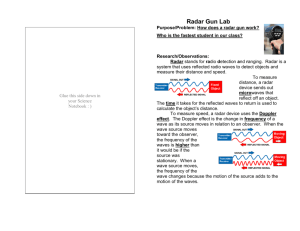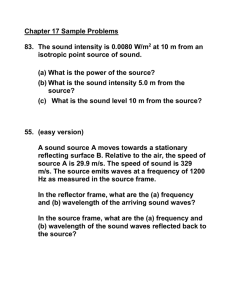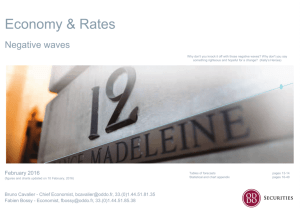Doppler Effect – Practical Applications
advertisement

Doppler Effect – Practical Applications Police Radar The handheld radar guns used by police to check for speeding vehicles rely on the Doppler effect. Here's how they work: 1. A police officer takes a position on the side of the road. 2. The officer aims his radar gun at an approaching vehicle. The gun sends out a burst of radio waves at a particular frequency. 3. The radio waves strike the vehicle and bounce back toward the radar gun. 4. The radar gun measures the frequency of the returning waves. Because the car is moving toward the gun, the frequency of the returning waves will be higher than the frequency of the waves initially transmitted by the gun. The faster the car's speed, the higher the frequency of the returning wave. 5. The difference between the emitted frequency and the reflected frequency is used to determine the speed of the vehicle. A computer inside the gun performs the calculation instantly and displays a speed to the officer. Doppler Radar Meteorologists use a similar principle to read weather events. In this case, the stationary transmitter is located in a weather station and the moving object being studied is a storm system. This is what happens: 1. Radio waves are emitted from a weather station at a specific frequency. 2. The waves are large enough to interact with clouds and other atmospheric objects. The waves strike objects and bounce back toward the station. 3. If the clouds or precipitation are moving away from the station, the frequency of the waves reflected back increases. If the clouds or precipitation are moving toward the station, the frequency of the waves reflected back decreases. 4. Computers in the radar electronically convert Doppler shift data about the reflected radio waves into pictures showing wind speeds and direction. Doppler images are not the same as reflectivity images. Reflectivity images also rely on radar, but they are not based on changes in wave frequency. Instead, a weather station sends out a beam of energy, then measures how much of that beam is reflected back. This data is used to form the precipitation intensity images we see all the time on weather maps, where blue is light precipitation and red is heavy precipitation. Doppler Echocardiogram A traditional echocardiogram uses sound waves to produce images of the heart. In this procedure, a radiologist uses a transducer to transmit and receive ultrasound waves, which are reflected when they reach the edge of two structures with different densities. The image produced by an echocardiogram shows the edges of heart structures, but it cannot measure the speed of blood flowing through the heart. Doppler techniques must be incorporated to provide this additional information. In a Doppler echocardiogram, sound waves of a certain frequency are transmitted into the heart. The sound waves bounce off blood cells moving through the heart and blood vessels. The movement of these cells, either toward or away from the transmitted waves, results in a frequency shift that can be measured. This helps cardiologists determine the speed and direction of blood flow in the heart. Sonic Booms The Doppler effect is used in many technologies that benefit people. But it can have a negative impact, as well. For example, sonic booms, which are caused by supersonic aircraft, can cause objectionable sounds and vibrations on the ground, which is why supersonic airplanes are not allowed to fly over populated areas. Sonic booms are directly related to the Doppler effect. They occur when airplanes, flying at the speed of sound or higher, actually fly faster than the sound waves they are producing. All of the waves bunch up behind the craft, in an extremely small space. When the bunched-up waves reach an observer, they are "heard" all at once -- as a resounding boom. The Air Force and NASA are experimenting with several inventions that help mitigate sonic booms. One such invention is a spike extending from the nose of the airplane. This spike essentially lengthens the plane and distributes the waves over a greater distance. This reduces the boom experienced by an observer on the ground.








